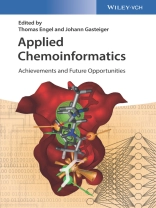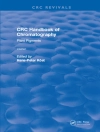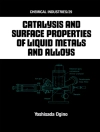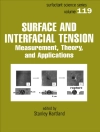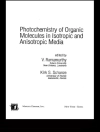Edited by world-famous pioneers in chemoinformatics, this is a clearly structured and applications-oriented approach to the topic, providing up-to-date and focused information on the wide range of applications in this exciting field.
The authors explain methods and software tools, such that the reader will not only learn the basics but also how to use the different software packages available. Experts describe applications in such different fields as structure-spectra correlations, virtual screening, prediction of active sites, library design, the prediction of the properties of chemicals, the development of new cosmetics products, quality control in food, the design of new materials with improved properties, toxicity modeling, assessment of the risk of chemicals, and the control of chemical processes.
The book is aimed at advanced students as well as lectures but also at scientists that want to learn how chemoinformatics could assist them in solving their daily scientific tasks.
Together with the corresponding textbook Chemoinformatics – Basic Concepts and Methods (ISBN 9783527331093) on the fundamentals of chemoinformatics readers will have a comprehensive overview of the field.
Tabela de Conteúdo
Foreword xvii
List of Contributors xxi
1 Introduction 1
Thomas Engel and Johann Gasteiger
1.1 The Rationale for the Books 1
1.2 Development of the Field 2
1.3 The Basis of Chemoinformatics and the Diversity of Applications 3
1.3.1 Databases 3
1.3.2 Fundamental Questions of a Chemist 4
1.3.3 Drug Discovery 5
1.3.4 Additional Fields of Application 6
Reference 7
2 QSAR/QSPR 9
Wolfgang Sippl and Dina Robaa
2.1 Introduction 9
2.2 Data Handling and Curation 13
2.2.1 Structural Data 13
2.2.2 Biological Data 14
2.3 Molecular Descriptors 14
2.3.1 Structural Keys (1D) 15
2.3.2 Topological Descriptors (2D) 16
2.3.3 Geometric Descriptors (3D) 16
2.4 Methods for Data Analysis 17
2.4.1 Overview 17
2.4.2 Unsupervised Learning 17
2.4.3 Supervised Learning 18
2.5 Classification Methods 19
2.5.1 Principal Component Analysis 19
2.5.2 Linear Discriminant Analysis 19
2.5.3 Kohonen Neural Network 19
2.5.4 Other Classification Methods 20
2.6 Methods for Data Modeling 20
2.6.1 Regression-Based QSAR Approaches 20
2.6.2 3D QSAR 22
2.6.3 Nonlinear Models 25
2.7 Summary on Data Analysis Methods 30
2.8 Model Validation 30
2.8.1 Proper Use of Validation Routines 31
2.8.2 Modeling/Validation Workflow 32
2.8.3 Splitting of Datasets 32
2.8.4 Compilation of Modeling, Training, Validation, Test, and External Sets 34
2.8.5 Cross-Validation 36
2.8.6 Bootstrapping 37
2.8.7 Y-Randomization (Y-Scrambling) 38
2.8.8 Goodness of Prediction and Quality Criteria 39
2.8.9 Applicability Domain and Model Acceptability Criteria 41
2.8.10 Scope of External and Internal Validation 43
2.8.11 Validation of Classification Models 45
2.9 Regulatory Use of QSARs 46
Selected Reading 48
References 49
3 Prediction of Physicochemical Properties of Compounds 53
Igor V. Tetko, Aixia Yan, and Johann Gasteiger
3.1 Introduction 53
3.2 Overview of Modeling Approaches to Predict Physicochemical Properties 54
3.2.1 Prediction of Properties Based on Other Properties 55
3.2.2 Prediction of Properties Based on Theoretical Calculations 55
3.2.3 Additivity Schemes for Property Prediction 56
3.2.4 Statistical Quantitative Structure–Property Relationships (QSPRs) 59
3.3 Methods for the Prediction of Individual Properties 59
3.3.1 Mean Molecular Polarizability 59
3.3.2 Thermodynamic Properties 60
3.3.3 Octanol/Water Partition Coefficient (Log P) 63
3.3.4 Octanol/Water Distribution Coefficient (log D) 67
3.3.5 Estimation of Water Solubility (log S) 69
3.3.6 Melting Point (MP) 71
3.3.7 Acid Ionization Constants 73
3.4 Limitations of Statistical Methods 76
3.5 Outlook and Perspectives 76
Selected Reading 78
References 78
4 Chemical Reactions 83
4.1 Chemical Reactions – An Introduction 84
Johann Gasteiger
References 85
4.2 Reaction Prediction and Synthesis Design 86
Jonathan M. Goodman
4.2.1 Introduction 86
4.2.2 Reaction Prediction 87
4.2.3 Synthesis Design 94
4.2.4 Conclusion 102
References 103
4.3 Explorations into Biochemical Pathways 106
Oliver Sacher and Johann Gasteiger
4.3.1 Introduction 106
4.3.2 The Bio Path.Database 110
4.3.3 Bio Path.Explore 111
4.3.4 Search Results 112
4.3.5 Exploitation of the Information in Bio Path.Database 117
4.3.6 Summary 129
Selected Reading 130
References 130
5 Structure–Spectrum Correlations and Computer-Assisted Structure Elucidation 133
Joao Aires de Sousa
5.1 Introduction 133
5.2 Molecular Descriptors 135
5.2.1 Fragment-Based Descriptors 135
5.2.2 Topological Structure Codes 135
5.2.3 Three-Dimensional Molecular Descriptors 137
5.3 Infrared Spectra 137
5.3.1 Overview 137
5.3.2 Infrared Spectra Simulation 138
5.4 NMR Spectra 140
5.4.1 Quantum Chemistry Prediction of NMR Properties 142
5.4.2 NMR Spectra Prediction by Database Searching 142
5.4.3 NMR Spectra Prediction by Increment-Based Methods 143
5.4.4 NMR Spectra Prediction by Machine Learning Methods 144
5.5 Mass Spectra 150
5.5.1 Identification of Structures and Interpretation of MS 150
5.5.2 Prediction of MS 151
5.5.3 Metabolomics and Natural Products 151
5.6 Computer-Aided Structure Elucidation (CASE) 153
Selected Reading 157
Acknowledgement 157
References 158
6.1 Drug Discovery: An Overview 165
Lothar Terfloth, Simon Spycher, and Johann Gasteiger
6.1.1 Introduction 165
6.1.2 Definitions of Some Terms Used in Drug Design 167
6.1.3 The Drug Discovery Process 167
6.1.4 Bio- and Chemoinformatics Tools for Drug Design 168
6.1.5 Structure-based and Ligand-Based Drug Design 168
6.1.6 Target Identification and Validation 169
6.1.7 Lead Finding 171
6.1.8 Lead Optimization 182
6.1.9 Preclinical and Clinical Trials 188
6.1.10 Outlook: Future Perspectives 189
Selected Reading 191
References 191
6.2 Bridging Information on Drugs, Targets, and Diseases 195
Andreas Steffen and Bertram Weiss
6.2.1 Introduction 195
6.2.2 Existing Data Sources 196
6.2.3 Drug Discovery Use Cases in Computational Life Sciences 196
6.2.4 Discussion and Outlook 201
Selected Reading 202
References 202
6.3 Chemoinformatics in Natural Product Research 207
Teresa Kaserer, Daniela Schuster, and Judith M. Rollinger
6.3.1 Introduction 207
6.3.2 Potential and Challenges 208
6.3.3 Access to Software and Data 211
6.3.4 In Silico Driven Pharmacognosy-Hyphenated Strategies 219
6.3.5 Opportunities 220
6.3.6 Miscellaneous Applications 228
6.3.7 Limits 228
6.3.8 Conclusion and Outlook 229
Selected Reading 231
References 231
6.4 Chemoinformatics of Chinese Herbal Medicines 237
Jun Xu
6.4.1 Introduction 237
6.4.2 Type 2 Diabetes: The Western Approach 237
6.4.3 Type 2 Diabetes: The Chinese Herbal Medicines Approach 238
6.4.4 Building a Bridge 238
6.4.5 Screening Approach 240
Selected Reading 244
References 244
6.5 Pub Chem 245
Wolf-D. Ihlenfeldt
6.5.1 Introduction 245
6.5.2 Objectives 246
6.5.3 Architecture 246
6.5.4 Data Sources 247
6.5.5 Submission Processing and Structure Representation 248
6.5.6 Data Augmentation 249
6.5.7 Preparation for Database Storage 249
6.5.8 Query Data Preparation and Structure Searching 250
6.5.9 Structure Query Input 253
6.5.10 Query Processing 254
6.5.11 Getting Started with Pub Chem 254
6.5.12 Web Services 255
6.5.13 Conclusion 255
References 256
6.6 Pharmacophore Perception and Applications 259
Thomas Seidel, Gerhard Wolber, and Manuela S. Murgueitio
6.6.1 Introduction 259
6.6.2 Historical Development of the Modern Pharmacophore Concept 260
6.6.3 Representation of Pharmacophores 262
6.6.4 Pharmacophore Modeling 268
6.6.5 Application of Pharmacophores in Drug Design 272
6.6.6 Software for Computer-Aided Pharmacophore Modeling and Screening 278
6.6.7 Summary 278
Selected Reading 279
References 280
6.7 Prediction, Analysis, and Comparison of Active Sites 283
Andrea Volkamer, Mathias M. von Behren, Stefan Bietz, and Matthias Rarey
6.7.1 Introduction 283
6.7.2 Active Site Prediction Algorithms 284
6.7.3 Target Prioritization: Druggability Prediction 292
6.7.4 Search for Sequentially Homologous Pockets 296
6.7.5 Target Comparison: Virtual Active Site Screening 298
6.7.6 Summary and Outlook 304
Selected Reading 306
References 306
6.8 Structure-Based Virtual Screening 313
Adrian Kolodzik, Nadine Schneider, and Matthias Rarey
6.8.1 Introduction 313
6.8.2 Docking Algorithms 315
6.8.3 Scoring 317
6.8.4 Structure-Based Virtual Screening Workflow 321
6.8.5 Protein-Based Pharmacophoric Filters 323
6.8.6 Validation 323
6.8.7 Summary and Outlook 326
Selected Reading 328
References 328
6.9 Prediction of ADME Properties 333
Aixia Yan
6.9.1 Introduction 333
6.9.2 General Consideration on SPR/QSPR Models 334
6.9.3 Estimation of Aqueous Solubility (log S) 336
6.9.4 Estimation of Blood–Brain Barrier Permeability (log BB) 342
6.9.5 Estimation of Human Intestinal Absorption (HIA) 346
6.9.6 Other ADME Properties 349
6.9.7 Summary 354
Selected Reading 355
References 355
6.10 Prediction of Xenobiotic Metabolism 359
Anthony Long and Ernest Murray
6.10.1 Introduction: The Importance of Xenobiotic Biotransformation in the Life Sciences 359
6.10.2 Biotransformation Types 362
6.10.3 Brief Review of Methods 364
6.10.4 User Needs: Scientists Use Metabolism Information in Different Ways 370
6.10.5 Case Studies 372
Selected Reading 382
References 383
6.11 Chemoinformatics at the CADD Group of the National Cancer Institute 385
Megan L. Peach and Marc C. Nicklaus
6.11.1 Introduction and History 385
6.11.2 Chemical Information Services 386
6.11.3 Tools and Software 388
6.11.4 Synthesis and Activity Predictions 391
6.11.5 Downloadable Datasets 391
References 392
6.12 Uncommon Data Sources for QSAR Modeling 395
Alexander Tropsha
6.12.1 Introduction 395
6.12.2 Observational Metadata and QSAR Modeling 397
6.12.3 Pharmacovigilance and QSAR 398
6.12.4 Conclusions 401
Selected Reading 402
References 402
6.13 Future Perspectives of Computational Drug Design 405
Gisbert Schneider
6.13.1 Where Do the Medicines of the Future Come from? 405
6.13.2 Integrating Design, Synthesis, and Testing 408
6.13.3 Toward Precision Medicine 409
6.13.4 Learning from Nature: From Complex Templates to Simple Designs 411
6.13.5 Conclusions 413
Selected Reading 414
References 414
7 Computational Approaches in Agricultural Research 417
Klaus-Jürgen Schleifer
7.1 Introduction 417
7.2 Research Strategies 418
7.2.1 Ligand-Based Approaches 419
7.2.2 Structure-Based Approaches 422
7.3 Estimation of Adverse Effects 429
7.3.1 In Silico Toxicology 429
7.3.2 Programs and Databases 430
7.3.3 In Silico Toxicology Models 432
7.4 Conclusion 435
Selected Reading 436
References 436
8 Chemoinformatics in Modern Regulatory Science 439
Chihae Yang, James F. Rathman, Aleksey Tarkhov, Oliver Sacher, Thomas Kleinoeder, Jie Liu, Thomas Magdziarz, Aleksandra Mostraq, Joerg Marusczyk, Darshan Mehta, Christof Schwab, and Bruno Bienfait
8.1 Introduction 439
8.1.1 Science and Technology Progress 439
8.1.2 Regulatory Science in Twenty-First Century 440
8.2 Data Gap Filling Methods in Risk Assessment 441
8.2.1 QSAR and Structural Knowledge 442
8.2.2 Threshold of Toxicological Concern (TTC) 443
8.2.3 Read-Across (RA) 445
8.3 Database and Knowledge Base 448
8.3.1 Architecture of Structure-Searchable Toxicity Database 448
8.3.2 Data Model for Chemistry-Centered Toxicity Database 449
8.3.3 Inventories 452
8.4 New Approach Descriptors 453
8.4.1 Tox Print Chemotypes 453
8.4.2 Liver Bio Path Chemotypes 458
8.4.3 Dynamic Generation of Annotated Linear Paths 459
8.4.4 Other Examples of Descriptors 461
8.5 Chemical Space Analysis 462
8.5.1 Principal Component Analysis 462
8.6 Summary 464
Selected Reading 466
References 466
9 Chemometrics in Analytical Chemistry 471
Anita Rácz, Dávid Bajusz, and Károly Héberger
9.1 Introduction 471
9.2 Sources of Data: Data Preprocessing 472
9.3 Data Analysis Methods 475
9.3.1 Qualitative Methods 475
9.3.2 Quantitative Methods 483
9.4 Validation 488
9.5 Applications 492
9.6 Outlook and Prospects 492
Selected Reading 496
References 496
10 Chemoinformatics in Food Science 501
Andrea Peña-Castillo, Oscar Méndez-Lucio, John R. Owen, Karina Martínez-Mayorga, and José L. Medina-Franco
10.1 Introduction 501
10.2 Scope of Chemoinformatics in Food Chemistry 502
10.3 Molecular Databases of Food Chemicals 503
10.4 Chemical Space of Food Chemicals 506
10.4.1 General Considerations 506
10.4.2 Chemical Space Analysis of Food Chemical Databases 508
10.5 Structure–Property Relationships 510
10.5.1 Structure–Flavor Relationships and Flavor Cliffs 511
10.5.2 Quantitative Structure–Odor Relationships 512
10.6 Computational Screening and Data Mining of Food Chemicals Libraries 513
10.6.1 Anticonvulsant Effect of Sweeteners and Pharmaceutical and Food Preservatives 514
10.6.2 Mining Food Chemicals as Potential Epigenetic Modulators 516
10.7 Conclusion 521
Selected Reading 522
References 523
11 Computational Approaches to Cosmetics Products Discovery 527
Soheila Anzali, Frank Pflücker, Lilia Heider, and Alfred Jonczyk
11.1 Introduction: Cosmetics Demands on Computational Approaches 527
11.2 Case I: The Multifunctional Role of Ectoine as a Natural Cell Protectant (Product: Ectoine, ‘Cell Protection Factor’, and Moisturizer) 528
11.2.1 Molecular Dynamics (MD) Simulations 530
11.2.2 Results and Discussion: Ectoine Retains the Power of Water 531
11.3 Case II: A Smart Cyclopeptide Mimics the RGD Containing Cell Adhesion Proteins at the Right Site (Product: Cyclopeptide-5: Antiaging) 533
11.3.1 Methods 536
11.3.2 Results and Discussion 536
11.4 Conclusions: Cases I and II 542
References 545
12 Applications in Materials Science 547
Tu C. Le, and David A. Winkler
12.1 Introduction 547
12.2 Why Materials Are Harder to Model than Molecules 548
12.3 Why Are Chemoinformatics Methods Important Now? 548
12.4 How Do You Describe Materials Mathematically? 549
12.5 How Well do Chemoinformatics Methods Work on Materials? 551
12.6 What Are the Pitfalls when Modeling Materials? 551
12.7 How Do You Make Good Models and Avoid the Pitfalls? 553
12.8 Materials Examples 554
12.8.1 Inorganic Materials and Nanomaterials 554
12.8.2 Polymers 557
12.8.3 Catalysts 558
12.8.4 Metal–Organic Frameworks (MOFs) 560
12.9 Biomaterials Examples 561
12.9.1 Bioactive Polymers 561
12.9.2 Microarrays 564
12.10 Perspectives 566
Selected Reading 567
References 567
13 Process Control and Soft Sensors 571
Kimito Funatsu
13.1 Introduction 571
13.2 Roles of Soft Sensors 573
13.3 Problems with Soft Sensors 574
13.4 Adaptive Soft Sensors 576
13.5 Database Monitoring for Soft Sensors 578
13.6 Efficient Process Control Using Soft Sensors 581
13.7 Conclusions 582
Selected Readings 583
References 583
14 Future Directions 585
Johann Gasteiger
14.1 Well-Established Fields of Application 585
14.2 Emerging Fields of Application 586
14.3 Renaissance of Some Fields 587
14.4 Combined Use of Chemoinformatics Methods 588
14.5 Impact on Chemical Research 589
Index 591
Sobre o autor
Johann Gasteiger is Professor emeritus of Chemistry at the University of Erlangen-Nuremberg, Germany and the co-founder of ‘Computer-Chemie-Centrum’. He has received numerous awards and is a member of several societies and editorial boards. His research interests are in the development of software for drug design, simulation of chemical reactions, organic synthesis design, simulation of spectra, and chemical information processing by neural networks and genetic algorithms.
Thomas Engel is is coordinator at the Department of Chemistry and Biochemistry of the Ludwig-Maximilians-Universitat in Munich, Germany. He received his academic degrees at the University of Wurzburg. Since 2001 he is lecturer at various universities promoting and establishing courses in scientific computing. He is also a member of the Chemistry-Information-Computer section (CIC) of the GDCh and the Molecular Graphics and Modeling Society (German section).
